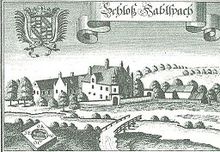Habelsbach Castle
The Habel Bach Castle is located in the town district Laberweinting in the Lower Bavarian district of Straubing-Bogen of Bavaria (Habel Bach 39).
history
Perchtoldus de Hawgoltzpach is attested here in 1295. Perhaps this was an ancestor of the Greul family, who later became wealthy there and who also appeared in Laberweinting at the beginning and in Grafentraubach in the middle of the 14th century. On January 7, 1305, the abbot Rüdiger and the Mallersdorf monastery of Marquart von Haugoltspach received his property in Pullach. On October 6, 1308, the monastery bought a property from Friedrich Gegninger zu Pullach through this Marquart . Perthold der Greul von Haugoltzpach, who is possibly identical to Perchtoldus mentioned in 1295, also sealed the document. 1330–1349 was another member of the Greuls Rüdiger der Graul von Haugoltspach in Habelsbach. 1349 Rueger der Graewl and his son Johann were mentioned. On June 15, 1349 gave the Rueger Graewl Habel Bach's hearing Allhaid of Draunspach the monastery Mallersdorf.
In 1381 the Inkofer exchanged goods, with Peter the Inkofer owning the Sedel , the headquarters and the building in Habelsbach. These goods came to the Inkofer through marriage into the Greuls family. On September 27, 1443, Martin Armannsperger sold to Christian Stinglheimer and the Regensburg a. a. his estate in Habelsbach. On March 7, 1444, Paul Vilser zu Habelsbach sealed a Mallersdorfer monastery charter.
The Vilser people in Habelsbach can be identified up to around 1500: Paul Vilser zu Habelsbach (1444), Leo Vilser (1470), Leo Vilser zu Haubolspach (1490, 1494 and approx. 1500). On September 15, 1492, Wilhelm von Münichau, caretaker and district judge zu Kirchberg , Georg Pützinger and Steffan Amman, who held the power of Abbalay, Leo Vilser's wife, requested the execution of a Gant concerning the Haselbach seat . However, Katharina Klugheimer objected to this through her lawyer, but these were rejected. The Ringheimers on Haselbach are attested for 1510–1578: Hans Rünkhamer (1510–1514), Michael Rünkhamer and Christoph Rünkhamer (1524–1578). At that time, Haselbach was already entered in the country table .
Wolfgang Viehböck zu Habelsbach was named as early as 1569. The Viehböcks were the Hofmark owners until 1617 : Christoph Viehböck (1597–1602), Christoph Viehböck, keeper of Rottenburg (1602–1615), 1616–1617 Viehböck's heirs. From 1623 the Viehböcks called themselves Count von und zu Haimhausen and are attested under this title on Habelsbach until 1642; Theodor von und zu Haimhausen (1623–1626), his heirs (1627–1628) and Hans Albrecht von und zu Haimhausen (1629–1642) appear in detail. In 1659, Philipp Jakob von Ginsheim zu Grafentraubach, who had married Anna Maria von Haimhausen, sat here. This Philipp Jakob von Ginsheim zu Schwabach also sat here in 1667. In 1689 the Hofmark was owned by the Barons von und zu Prinkberg zu Habelsbach, Kastner zu Aibling. It cannot be determined exactly when the Hofmark came to the von Axthalb; Habelsbach was in this family from 1752 until after 1781. In 1781, after the death of the mayor of Axthalb, the Hofmark passed to his cousin Joseph von Axthalb.

Habelsbach Castle then and now
After the engraving by Michael Wening from 1721, the castle was a two-story complex with a residential building with a dormer window . A second residential building appears to the south behind this building, and behind it a farm building. The facility is enclosed by a low wall, with access through a gate tower placed at a corner.
Today the former castle has been converted into a residential building. It is a small two-wing complex, the core of which dates from the 16th and 17th centuries. Century. The roof is modernized. On the south-east side of the north wing there is still the corner-positioned, square tower with octagon and tent roof . Today the facility is privately owned.
literature
- Günther Pölsterl: Mallersdorf. The Kirchberg regional court, the Eggmühl and Abbach nursing courts. (= Historical Atlas of Bavaria, part of Altbayern booklet 53), pp. 178–180. Commission for Bavarian History, Verlag Michael Lassleben, Munich 1979, ISBN 3-7696-9923-8 .
Web links
- Entry on Habelsbach Castle in the private database "Alle Burgen".
- Habelsbach Castle
- Habelsbach Monument List
Coordinates: 48 ° 48 ′ 13.6 ″ N , 12 ° 18 ′ 38.5 ″ E


